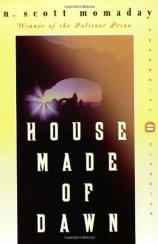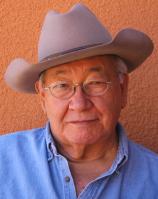Reading Group Guide
Discussion Questions
House Made of Dawn

1. What bearing does the Navajo Night Chant in Chapter 3 have on the novel, on Abel's life and future, and on the lives of Abel's people? How is it significant that it is Ben who sings the chant to Abel on the Los Angeles hill? What and where is the House Made of Dawn?
2. What is the importance of dawn and dusk? What events and activities in Abel's life and the lives of his people, mythic and actual, occur at these two times of day? What is the significance of the novel's beginning and ending with Abel's dawn run? Are there any differences between the two presentations of his run?
3. Why does Abel kill the albino? What does the albino--and therefore whiteness--symbolize for the people of Walatowa?
4. How does Momaday evince the Tano people's regard for the land and its creatures? What specifics or landscape and fauna are presented as deserving of particular reverence? Why? What is special about the Valle Grande, Black Mesa, and other specific natural sites and features?
5. Why does Momaday have Ben Benally, the assimilated Navajo, narrate Abel's post-prison activities in Los Angeles, and intersperse Ben's narrative with Abel's memories? Why might Ben's sympathetic understanding of Abel be important to our understanding?
6. What are Fray Nicholas's and Father Olguin's relationships to the people of Walatowa? How do their Christian beliefs and rituals compare or contrast with Indian beliefs and rituals? What biblical references are there, including those to Genesis and to the Gospel of St. John? What purpose is served in this regard by Tosamah, Priest of the Sun?
7. What is Momaday's purpose in telling his story through present-day narrative interspersed with flashbacks and memories? How do Abel's and Francisco's memories of past events help us to understand the circumstances of their present lives and the ways of their people?
8. What is the nature of the relationship between Abel and Angela St. John? To what extent does Angela represent white society's attitude toward Native Americans?
9. What Tano rituals and ceremonies are described? How do they help us understand the way of life from which Abel has become estranged? How do they help us understand that estrangement?
10. What instances of violence occur? To what extent is each an instance of the "sacramental violence" that Angela sees in Abel's cutting of the firewood? How is this "sacramental violence" related to the "attitude of non-being" that Angela observed in the corn dancers at Cochiti and to other ceremonies?
11. What is the importance of the Middle, the town's "ancient place," and of its kiva? What events take place there, and at what points in the story? What other references are there to middle or central places?
12. What is the importance of Tosamah's sermons on the Gospel of John, the truth of "the Word," and his storyteller grandmother, who "learned that in words and in language, and there only, she could have whole and consummate being"? What is the purpose of his comments on the white man's use of language?
13. How would you explain Abel's "desperate loneliness" and fear ("He had always been afraid")? In what ways do they intensify during his stay in the village, his time in prison, and his stay in Los Angeles? How true is Tosamah's claim that "Loneliness is there as an aspect of the land"?
14. Who are the runners after evil whom Abel hears when he comes to after his beating? In what ways are they related to the Dawn Runners and to the race of the dead in Chapter 4? In what ways does Abel take on the attributes of both a dawn runner, a runner after evil, and a participant in the race of the dead?
15. What are the similarities and differences among Abel's, Francisco's, Ben's, and Tosamah's attitudes toward Native American life and white society?
House Made of Dawn
- Publication Date: July 1, 1999
- Paperback: 198 pages
- Publisher: Harper Perennial Modern Classics
- ISBN-10: 0060931949
- ISBN-13: 9780060931940








